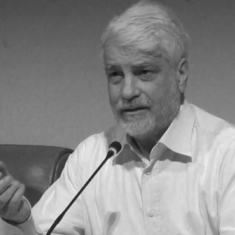 |
|
Ellen MacArthur, a 28 year old sailor who in 2005 broke the record of solo circumnavigation of the world in just 71 days |
To survive the solitude of the ocean, she understood the importance of managing scarce resources such as food, water and equipment. Ellen MacArthur – a 28 year old English sailor – in 2005 beat the record of single-handed circumnavigation of the globe in only 71 days. In the following years, she did not give up her passion for boats, but she decided to transfer the philosophy she developed while sailing to the production world. So, she created an eponymous Foundation with the aim of “speeding up the transition towards a circular economy.”
Indeed, the economy must deal with finite resources. If the prevailing model of linear development – where the throwaway rationale rules unchallenged – is not brought into dispute, over the next decades the availability of several elements such as gold, silver, indium, iridium and tungsten is bound to dwindle.
 |
|
©Shutterstock |
The focus on the positive effects of a circular economy has led to in-depth analyses on various scales.
An interesting study on the prospects of the circular economy at a national level has been conducted in Holland. After analysing 17 groups of electronic and mechanical products, it has been estimated that against a turnover of €16.5 billion a year, the current level of “circularity” already enables earnings in the region of €3.3 billion (equalling 20%). More maintenance, reuse and recycling would increase the income by €0.5 billion.
This would certainly entail a cutback in the sale of new products, with no domestic effects in the case of Holland, since they are imported. Actually, the advantage linked to the diminished imports is estimated at €0.4 billion, bringing the benefits to €0.9 billion a year, in addition to the creation of 10,000 new jobs (figure 1).
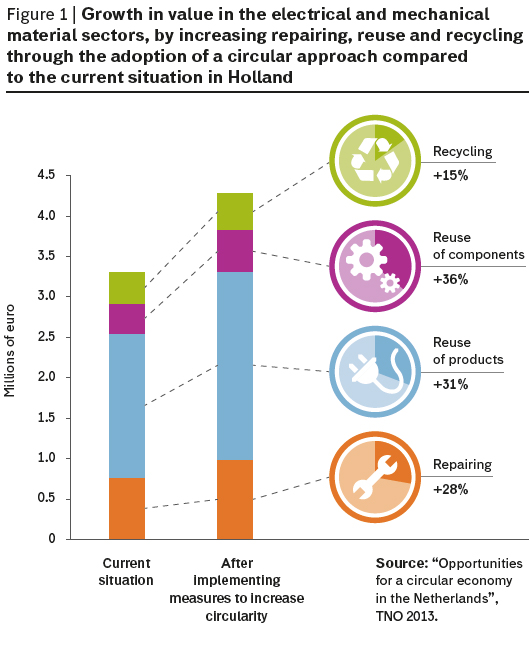
By spreading the advantages of the circular economy to the whole Dutch production sector, a growth of €7.3 billion a year, amounting to 1.4% of GDP, has been estimated, with 54,000 more jobs. How long would it take to start such transition? About fifteen years, but with half of the benefits concentrated in the first three-year period.
And this is a path that Holland is already facilitating. In 2013, Rabobank, for example, funded “circular” operations of Dutch companies with €740 million, aiming at increasing considerably its support in the next few years.
Such analysis applied to a small country sheds light on the great potential linked to the propagation of such philosophy.
At global level, the scope of action is obvious: in 2010, 65 billion tons of raw materials entered the production cycle and a mere 20% were reutilized. Redesigning production modes and enhanced recovery of materials could boost such percentage to 50%.
The development of the potential of a circular economy would enable to revert the current trend and to redirect it towards a better and lower use of matter and energy.
In actual facts there are virtuous examples of reuse and recovery of materials, in particular in countries with little raw materials: so, for example, Japan recycles 98% of metals.
And several countries, along with the improvement of energy efficiency, are reducing the intensity of their use of materials.
The United Kingdom is a case in point. In 2000, the English economy absorbed 520 million tons of raw materials, recovering and reusing only 50 million. Ten years later, following an economic growth of 20%, the use of raw materials dropped to 420 million tons and, more importantly, the amount of recycling more than doubled, amounting to 115 million tons, thanks to a host of activities offering employment to 130,000 people (figure 2).
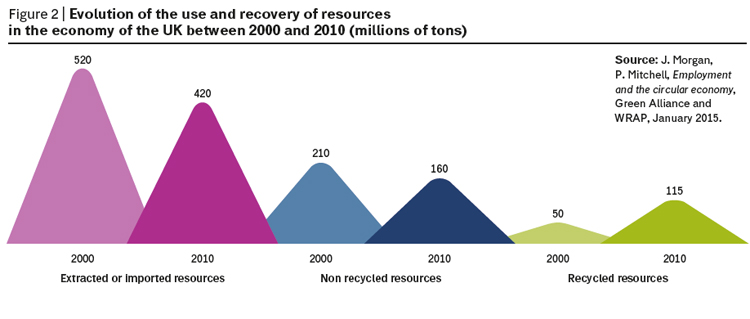
So, albeit unevenly, a more efficient use of resources is occurring. However, such trend could definitely be accelerated, since the benefits and the employment opportunities deriving from it are substantial.
With regard to the United Kingdom, provided effective policies encouraging the circular economy are in place, there would be an increase of half a million jobs by 2030. Obviously a growth in the recovery, reuse and recycling fields means a reduction of jobs in the traditional sectors. It is therefore important to consider net employment growth, which in the United Kingdom has been estimated at 100,000 jobs by the end of the next decade.
So, a smart policy, identifying ambitious objectives, removing obstacles and facilitating the transformation of the economy not only enables a more rational use of resources but it offers a positive balance-sheet as far as employment is concerned.
At European level, the picture is almost identical. The figures of the raw materials used in 2012, taking into consideration also those linked to the production of imported and exported products (Raw Material Consumption, RMC), are slightly lower compared to 2000, with 16% of GDP growth (figure 3).
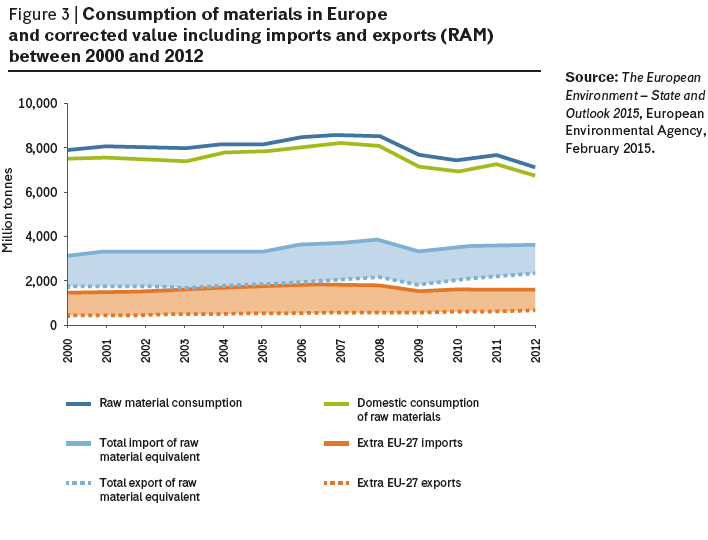
At global level, the rise of productivity of resources by 2030 associated with the adoption of “circular” policies would allow to reduce dramatically the demand for minerals, energy, water and land (in some sectors by 30%), thus contributing to defuse tensions and prices instability.
It is therefore surprising, both because of the good results and following the evidence provided by the studies conducted by the Commission itself, that Europe has slowed down on the policy package and objectives regarding the circular economies. At the end of February, such measures have indeed been set aside: a ghastly sign, lessened by the promise of resuming the debate on the subject in the future in a “more ambitious” manner.
However, such uncertainty will not slow down the effort by those in the industrial sector more scrupulous and interested in “circularity” and the designing of products that can be disassembled, rebuilt and recycled.
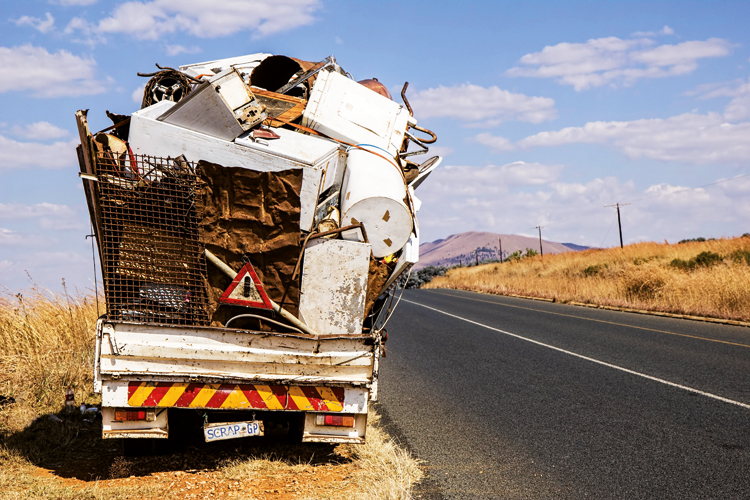
Just to speed up these processes, the MacArthur Foundation forged an alliance with the World Economic Forum, with the aim of involving important industrial groups covering 5-10% of the world market of plastics, paper, electronics and home appliances, within Project Mainstream. These sectors offer good scope for action.
93% of polyethylene terephthalate (Pet) used in packaging is still produced from virgin materials. The target is to reduce by 10% the unrecovered share, thus creating a value of $4 billion a year.
The improvement of paper recovery in those countries where such activity is still weak would enable a valorisation of $10 billion a year. But the electronic material and home appliances sector could benefit enormously. At the end of their cycle, they are valued at $390 billion a year. In such area, the implementation of concerted measures and policies could lead to a valorisation of $52 billion a year.
As it can be gathered, these are ambitious programs which could be accelerated with the adoption of appropriate regulations, as it happened in France, where in March a law against planned obsolescence was put in place. But in order for them to be effective we need to raise the bar. And Europe must regain its leading role.
This article draws on and expands on some of the contents of the book Due Gradi (“Two Degrees”) by Gianni Silvestrini, Edizioni Ambiente, 2015.


